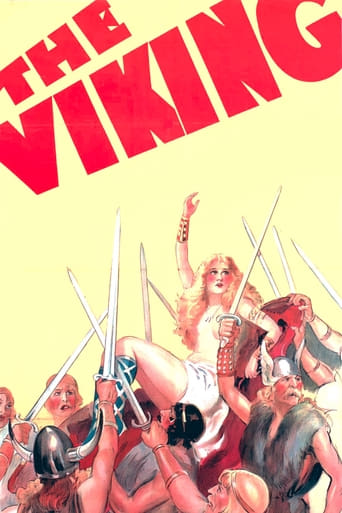



Sadly Over-hyped
It's entirely possible that sending the audience out feeling lousy was intentional
View MoreIt's the kind of movie you'll want to see a second time with someone who hasn't seen it yet, to remember what it was like to watch it for the first time.
View MoreIt is both painfully honest and laugh-out-loud funny at the same time.
View More"The Viking" is a very old fashioned film, though at the time audiences must how been wowed since it was made using the Two-Strip Technicolor process. This created color...of a sort. These films tend to actually looks more green-orange because those are the two colors that are overlayed to create a sort of color look. However, while other studios were converting to sound, MGM chose to make this epic as a silent--which, along with the rest of the film, is pretty old fashioned in its view of Vikings.True Vikings did not wear the horned-helmets or hawk winged helmets you see throughout this movie. Their costumes also were far more practical than the silly outfits worn in "The Viking". What gives? Well, the costume designer actually was designing vikings according to how Wagnerian operas portrayed them. It was 100% wrong--but fit the image that Wagner was trying to create in his crazy operas. So, the film is sort of like a Wagner story without the music!As for the story, it's actually seemingly true in some ways. Eric the Red really did have a son named Leif who apparently was among the first white folks in North America. Interestingly, however, back in the 1920s. That's because the only 'proof' of this voyage were the Viking sagas--stories sung to celebrate the feats of the Vikings but have no real proof to them. This proof did not come until more recent years when Norwegian expeditions were able to find some artifacts in Canada that must have been brought by Vikings.So is the film any good? Well, the plot involving a captured slave who captures the heart of a Viking girl is pretty silly. The part about Ericsson and his voyage is a bit more exciting however, and makes up, a bit for the silly romance and dumb costumes.Overall I say you'd be much better off watching the 1958 film "The Vikings". It's more historically accurate, much more exciting and has just about everything you could want in such a film.
View MoreI enjoyed this fun movie and for the most part it was historically correct until the ending. SPOILER: The Vikings did NOT build the stone tower in Rhode Island which was built in 1700s. Proof of the Viking settlement came in 1960 (over 30 years after movie, 1928). Archaeological diggings of Vikings were found at northern tip of Newfoundland, Canada, at a now famous site called "L'Anse aux Meadows". Viking voyage to Newfoundland was in year 1,000 AD approx. After several years fighting with Indians and almost freezing to death, the Vikings gave up their North America venture. I saw Viking tools a few years ago on display in museum in St.John's in Newfoundland. SPOILER - there is no evidence that Vikings wore horns on their heads (although Helga makes a fashion statement with her head-dress). As Hitchcock famously said over a mistake an actor made - "it's only a movie".
View MoreThe distinction of being the first all-Technicolor feature can't save this silent melodrama from being the tongue-in-cheek relic it now is, but of course there hasn't yet been a Viking saga made that was able to avoid the booby-trap of built-in silliness. Even so, this tempestuous (and ridiculous) Norse romance stretches credibility to the limit, boldly revising history to introduce Lucky Leif Eriksson as an early disciple of Christianity, defying his father's pagan beliefs and planting the cross of Jesus on the shores of a New World (said to be Rhode Island), where he promptly begins converting the natives to the One True Faith. Somehow the textbooks not only missed this fact, but also overlooked the passionate love quadrangle between Leif, a beautiful young Valkurie he secretly loves, a handsome young English slave, and a sinister sea captain. The novelty of color was not enough to turn audiences away from the far richer treasures of black and white film; like 3D in later decades, color was not, in the 1920s, something to be regarded seriously, and on the evidence of lively hooters like The Viking it's easy to see why.
View MoreThere are so many two-strip Technicolor features lost (Laurel and Hardy's The Rogue Song (1930) comes to mind) or just partially intact, that it was a pleasure to see one that seems not only intact (with no black and white inserts) but also as beautiful as originally released. This film is not colorized, as is often done with early black and white films; it was filmed in color, but without the yellow component that was added in the mid 30's that most of us know as Technicolor. As a result, the reds, blues and browns look pretty good, but you will notice the yellows and greens look a bit off color. Still, it is a great example of the process and worth seeing for that reason alone. But there are also some good action sequences that are sure to please lovers of that genre. I also enjoyed the backdrop of the plot; that of Leif Ericsson sailing west to discover America in the 12th century.
View More